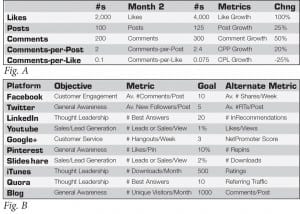Under ever-increasing pressure to prove return on investment, marketers have made attempts to assign a value to Facebook likes and Twitter followers. Industry researchers and lawyers alike are happy to provide numbers, but is there any value in numbers like $3.60 per Facebook like or $2.50 per Twitter follower? Not much, unless you are also considering your objective, audience and offering.
Tracking metrics that provide real insights has proven to be a challenge and, regrettably, marketers are focusing on the wrong metrics resulting in poor strategic decisions.
According to an eConsultancy survey, two thirds of companies didn’t have any clear way of measuring what they were doing on social media and most aren’t measuring the performance of activities against their social media objectives. Outlined in this article is a model that moves from tracking simple awareness and engagement with absolute numbers to ratios that provide true insights.
Before we dive in, let me take a moment to explain the concept of ratios as key performance indicators (KPIs). For starters, the standard model for social media measurement is to track simple awareness and engagement. Awareness metrics include total number (or percentage growth) of “likes,” fans, followers, subscribers or views. Typical engagement metrics include total quantity or quality of shares, comments, retweets, replies, ratings or conversations.
While these metrics can certainly help set a baseline and provide trending for general reach and frequency, they can be misleading or misinterpreted as absolute values. One way to minimize the limitations of these metrics is to track them as ratios instead.
For example, marketers shouldn’t care as much about the total number of “likes” on Facebook; rather, they should care about the level of quality and engagement with those individuals. One way to do that is by looking at relationships like the average number of comments or shares-per-post. In that scenario, the focus is on the relative quality of engagement over time. The absolute numbers in this scenario may look to be increasing, but when compared relative to each other, total engagement may be decreasing.
In the Facebook example (Fig. A), the “Old School” social media marketing manager would claim success, based on month-to-month “like,” post and comment growth. However, this does not provide the full picture. If we dig deeper, you’ll notice the comment-per-like ratio is actually down as other areas grow. As CMO, I would call out the discrepancy, as it implies overall social media engagement is in fact down, not up. Keep in mind, this is an overly-simplified example meant to illustrate the power of ratios.
RATIO-BASED METRICS
As you can see from the example, I’m compelled to create a matrix at any opportunity.
In Fig. B, I felt a matrix was the easiest way to communicate a sampling of ratio-based metrics for social media platforms, based on objective. I also included sample goals and alternative metrics. These are not meant to be de facto metrics for all social media marketing efforts. Rather, they are meant to foster conversation and inspire you to create your own meaningful metrics.
Every business is unique and thus the nature of your business will impact which metrics are most valuable to you. I encourage you to review and discuss this matrix with your executive and marketing team. To get your discussion started, ask the following questions:
• Which platforms are most relevant to our target audience? Using customer insights and knowledge, determine which platforms your prospects and customers use. Once you determine where your customers are socially, determine which platform will be most effective in reaching them.
• Which objective is a priority for each of those platforms? Now that you know where to reach your customers, determine objectives for each platform. Map your objective to the strengths of each platform, based on user behavior and your communications or business goals.
• Does the sample metric make sense for your business? There is no “one-size-fits-all” approach. Consider factors like business structure, product or service type and your sales funnel. Run sample data through and see what insights it provides. I suggest one to three months for a test, depending on volume of data. You then have a baseline and can make tweaks if necessary.
• What goal is most realistic based on your current objectives, audience, resources and timelines? Now that you have a baseline, it’s time to set a goal. Factor in objectives, audience, resources and timeline to set your baseline goal. Create a stretch goal—which may be 10%-50% higher. This gives you incentive to work towards.
• Are there any secondary metrics you should consider? Is there any other data you need to make informed decision about your social campaigns?
Once you have answered the questions above to your satisfaction and complete an initial test, you should discover entirely new insights.
Armed with these new insights you can make decisions about how to best allocate your social media resources to maximize return-on-investment (ROI) on your overall marketing program. PRN
[This article is an excerpt from PR News ’ Digital PR Guidebook.]
The Matrix: Tracking Social Channels
CONTACT:
This article was written by Kent Lewis, founder and president of Anvil Media Inc. He can be reached at [email protected].
Meaningless Measurement: Social Metrics to Avoid
By Kent Lewis

Meaningless metrics create a host of issues such as wasting time, wasting money and making uniformed decisions based on inaccurate, incomplete or incomprehensible data. Here’s my list of the four dumbest social media metrics to avoid.
• Content volume: There’s no prize for generating more tweets than your competitors, other than a greater likelihood of you annoying people and losing followers. It’s a simple case of quality over quantity.
• Number of “likes,” followers or fans: These are arbitrary numbers and can’t be compared across platforms. The value of each is different for every business.
• Impressions: A one-dimensional metric often associated with YouTube. What if 990 of your 1,000 views come from your mother, a university student in Japan or a robot?
• Klout: While I regularly keep tabs on my personal Klout score, it measures an extremely limited slice of the social universe and can be easily “gamed.”

